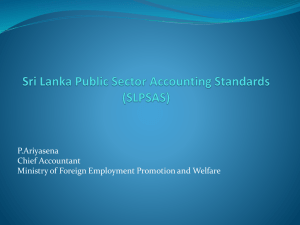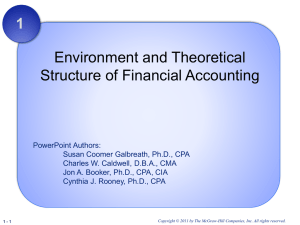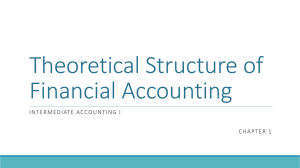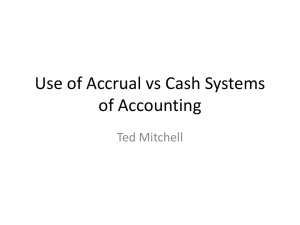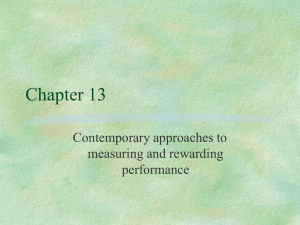Conversion Table between Fiscal Data of CR and Standard ESA
advertisement
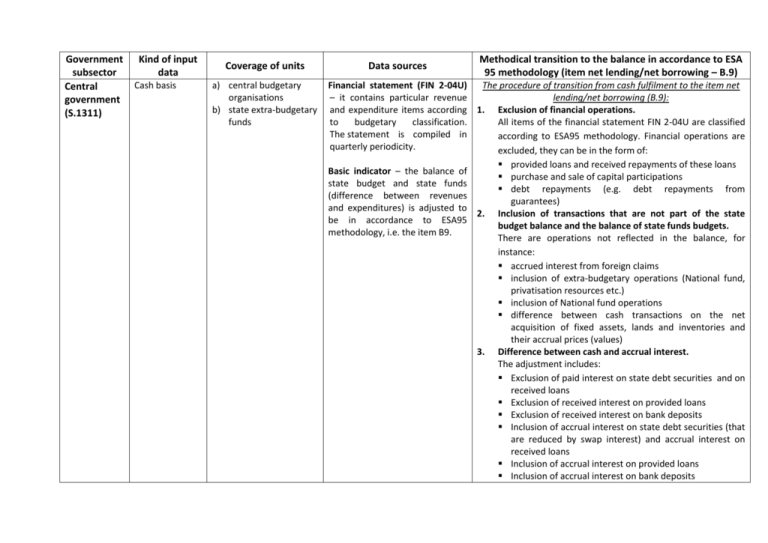
Government subsector Central government (S.1311) Kind of input data Cash basis Coverage of units a) central budgetary organisations b) state extra-budgetary funds Data sources Methodical transition to the balance in accordance to ESA 95 methodology (item net lending/net borrowing – B.9) Financial statement (FIN 2-04U) The procedure of transition from cash fulfilment to the item net – it contains particular revenue lending/net borrowing (B.9): and expenditure items according 1. Exclusion of financial operations. to budgetary classification. All items of the financial statement FIN 2-04U are classified The statement is compiled in according to ESA95 methodology. Financial operations are quarterly periodicity. excluded, they can be in the form of: Basic indicator – the balance of state budget and state funds (difference between revenues and expenditures) is adjusted to 2. be in accordance to ESA95 methodology, i.e. the item B9. 3. provided loans and received repayments of these loans purchase and sale of capital participations debt repayments (e.g. debt repayments from guarantees) Inclusion of transactions that are not part of the state budget balance and the balance of state funds budgets. There are operations not reflected in the balance, for instance: accrued interest from foreign claims inclusion of extra-budgetary operations (National fund, privatisation resources etc.) inclusion of National fund operations difference between cash transactions on the net acquisition of fixed assets, lands and inventories and their accrual prices (values) Difference between cash and accrual interest. The adjustment includes: Exclusion of paid interest on state debt securities and on received loans Exclusion of received interest on provided loans Exclusion of received interest on bank deposits Inclusion of accrual interest on state debt securities (that are reduced by swap interest) and accrual interest on received loans Inclusion of accrual interest on provided loans Inclusion of accrual interest on bank deposits 4. 5. Adjustment by reason of accrualization of chosen nonfinancial accounts items carried out on the base of data on transactions with related claims and liabilities: Difference between the accrual amount of taxes and fees (time adjustment method used for chosen tax items) and their cash flows Difference between the accrual amount of social security contributions and contributions to the state employment policy (time adjustment method) and their cash flows Difference between the accrual amount of compulsory accident insurance and its cash flows Adjustment of social benefits by advance payments to the Czech Post Office (i.e. payment provided by the Czech Administration of Social Security in December of the current year for pensions that are paid in advance in January of the next year Adjustment of revenues and expenditures of State Fund for Transport Infrastructure by advance payments on EU grants Exclusion of EU flows for other than general government that influence the state budget balance EU corrections (Corrections of EU subsidies) – the amount of expenditures paid in advance from the state budget on behalf of EU that are not finally certificated by EU Accrualization of the production by change in the accounts Trade receivables and Provided advance payments Accrualization of the intermediate consumption by change in the items Accounts payable and Received advance payments (Customer advances) Liabilities on unpaid (unsettled) sugar levies – sugar levies are collected by State Agricultural Intervention Fund, but they are paid in the next year Other adjustments c) state semi budgetary organizations Annex M. Additional information on income and expenditure of the Decree No. 410/2009 Coll. – contains items of revenue and expenditure by type. The statement is available in quarterly periodicity. The basic indicator – the balance of revenue and expenditure of the non-financial cash flows. accrual basis d) units keeping accounts according to the Decree No. 500/2002 Coll. implementing some The Czech Statistical Office uses following data sources for National accounts compilation: P/L account – includes individual items of revenues and costs There are recorded the adjustments belonging to none of the categories 1.-4. They include for instance: Debt assumption or debt forgiveness Reclassification of operating leasing to financial leasing (e.g. in a case of military equipment) Internal transfers within an accounting entity recorded as revenues according to budgetary classification, but they are not (do not represent) nonfinancial transactions in ESA95 methodology The process of transition from Annex M. Additional information on income and expenditure (Statement of cash flows) to the item net lending/borrowing (B.9) 1. The adjustment to gross capital formation. It is necessary to exclude part B. Cash flows from investments in nonfinancial assets and vice versa to include the gross capital formation. Data on gross capital formation are drawn from complementary sources Auxiliary Analytical Overview (AAO) and statistical survey (report VI 1-01). 2. The difference between the reported and accrued interest. 3. Accrual adjustment of selected items of non-financial accounts on the basis of data on transactions with related receivables and liabilities. These adjustment includes e.g.: accrualization of income from sales of goods and services by change in the accounts Trade receivables and Advance payments given accrualization of purchases of goods and services by change in the accounts Trade payables and Advance payments received. 4. Other adjustment: exclusion of exchange rates profits and losses etc. The Czech Statistical Office makes following adjustments of data sources for national accounts compilation. The difference in the conception of both balancing items, i.e. profit/loss as a balancing item of the Profit and Loss Statement and net lending/net borrowing as a balancing item of the non-financial accounts, is provisions of the Act No. 563/1991 Coll., on accounting, as amended, for accounting units, which are entrepreneurs keeping their books in the double-entry accounting system, i.e. the Supporting and Guarantee Agricultural and Forestry fund a.s., the Railway Infrastructure Administration, Center-F, non-market public corporations ČPP Transgas and Balmed. e) units keeping accounts according to the Decree 504/2002 Coll. for reporting entities whose primary activities are not focused on business and are keeping accounts in the double-entry accounting system. This group contains public universities, public research labelled, divided and arranged in accordance with the relevant decree. Statements are available in quarterly periodicity. Statistical survey – statements NI 1-01 and P5-01 for entities where administrative accounting statements are not available (ČPP Transgas, Balmed, public research institutions). Transaction coverage and accrual approach of these statistical statements are fully compatible with the P/L account compiled in accordance with the Decree No. 500/2002 Coll. or 504/2002 Coll. on which these units use for keeping accounts according to doubleentry accounting system. These surveys provide also figures on acquisitions of non-financial assets for relevant units (P5-01 for ČPP Transgas and Balmed and NI 1-01 for public universities, public research institutions, Council for Public Supervisory over Audit and Viticultural Fund). determined by using of ESA 95 methodology at basic accounting statements. The items of data sources are classified into relevant items of national accounts according to ESA 95 methodology. This classification of data sources items into the ESA 95 ones influences whether and how their values will be recorded in net lending/net borrowing. For a direct transition from the profit/loss to net lending/net borrowing it is necessary to take into account following adjustments: 1. Exclusion of financial operations and other economic flows The item profit/loss includes revenues and costs connected with purely financial operations and other economic flows (e.g. revenues from sales of securities and shares, sold securities and shares, exchange rate profits/losses, claim depreciations by reason of debtor´s bankruptcy etc.). Profits/losses that are connected with it, are recorded on the revaluation account, all the purely financial operations enter only on financial accounts and do not have any impact on the value of balancing item B.9 in non-financial accounts. Therefore these items must be eliminated for a direct transition from the balance of revenues and costs to the item B.9. 2. Completeness of non-financial flows included in the balance Regarding the balance corresponds to the balance of revenues and costs, it is necessary to carry out some adjustments by reason of transactions with non-financial assets that are not included in this balance, but they must be recorded in the item B.9, or on the other hand by reason of transactions that are part Statistical survey VI 1-01 – of the balance but they should not influence the item B.9. complementary source, provides data which are not included in These adjustments are made: P/L account (mainly acquisitions adjustment connected with a gross capital formation not included in balance (-). The P/L account do not include of non-financial assets and information on acquisitions of non-financial assets. These transfers) for the Supporting and figures are taken from complementary resources (see Guarantee Agricultural and institutions, Council for Public Supervisory over Audit, Viticultural Fund. Forestry fund, the Railway Infrastructure Administration, Center-F, PRISKO and also for the semi-budgetary organisations the data of which are not included in the Auxiliary Analytical Overview. 3. Local government (S.1313) Cash basis a) b) c) d) municipalities regions regional councils of cohesion regions voluntary associations of municipalities Financial statement (FIN 2-12M) – it contains particular revenue and expenditure items according to budgetary classification. The statement is compiled in monthly periodicity. For compiling indicators according to ESA95 methodology are used only quarterly data. Basic indicator – the balance of local budgets (difference between revenues and expenditures) is adjusted to be in accordance to ESA95 paragraph on data sources) investment transfers are not included in the P/L account, either. Their value must be reflected in B.9, the counterparty information is also crucial for these transactions. adjustments connected with accounting depreciation and amortization of non-financial assets (+). Accounting depreciation and amortization included in costs influence the value of profit/loss but not the value of B.9 Other adjustments the exclusion of creation (+)/(-) use of provisions and allowances financial leasing: adjustment reflects an exclusion of costs for financial leasing (repayments of financial leasing) from balance (+) and an inclusion of related imputed interests (-). DATA REQUIRED BY A DIRECTIVE 2011/85/EU ARE NOT AVAILABLE The procedure of transition from cash fulfilment to the item net lending/net borrowing (B.9): 1. Exclusion of financial operations. All items of the financial statement FIN 2-12M are classified according to ESA95 methodology. Financial operations are excluded. They are in the form of: provided loans and received repayments of these loans purchase and sale of capital participations debt repayments (e.g. debt repayments from assumed guarantees) 2. Inclusion of transactions that are not part of the budget balance. There are operations not reflected in the balance, for instance: difference between cash transactions on the net acquisition of fixed assets, lands and inventories and their accrual prices (values) methodology, i.e. the item B9 in nonfinancial accounts. 3. 4. Difference between cash and accrual interest on debt securities (that are reduced by swap interest) and accrual interest on received loans Adjustment by reason of accrualization of chosen nonfinancial accounts items carried out on the base of data on transactions with related claims and liabilities, for instance: Difference between the accrual amount of taxes and fees (time adjustment method used for chosen tax items) and their cash flows Exclusion of EU flows for other than general government that influence the budget balance EU corrections (Corrections of EU subsidies) – the amount of expenditures paid in advance from the budget on behalf of EU that are not finally certificated by EU Accrualization of the production by change in the accounts Trade receivables and Provided advance payments Accrualization of the intermediate consumption by change in the items Accounts payable and Received advance payments (Customer advances) Other adjustments There are recorded the adjustments belonging to none of the categories 1.-4. They include for instance: Debt assumption or debt forgiveness Reclassification of operating leasing to financial leasing Internal transfers within an accounting entity recorded as revenues according to budgetary classification, but they are not (do not represent) nonfinancial transactions in ESA95 methodology Accrual basis e) semi budgetary units established by municipalities, regions and voluntary associations of municipalities f) other local government units So-called local semi budgetary units keep their accounts in accordance with Decree 410/2009 Coll., implementing certain provisions of Act No 563/1991 Coll., on Accounting, as amended, for national accounts compilation. The Czech Statistical Office uses this accrual data as a main source for semi budgetary units. Auxiliary analytical overview, submitted by some semi budgetary units pursuant to Decree 383/2009 Coll. as amended, is used as an additional data resource providing information that is not included in the profit and loss statement. Finally, statistical surveys VI 1-01 are information source for data not included in profit/loss statement (especially for nonfinancial assets acquisition and transfers free of charge) – institutions for which these data are not presented in the Auxiliary analytical overview submitted pursuant to Decree 383/2009 Coll., as amended. The Czech Statistical Office uses statistical surveys P 5-01 submitted on a yearly basis for units, which keep accounting records in accordance with The Ministry of Finance publishes data compiled from the profit and loss statement (submitted on a quarterly basis according to Decree No. 410/2009 Coll., Implementing certain provisions of Act No. 563/1991 Coll., On Accounting, as amended, for some selected entities). Data from profit and loss statements are grouped to the structure as possible closer to the parameters, which are based on the GFSM 2001 (Government Finance Statistics Manual 2001) prepared by the International Monetary Fund. The procedure of transition from profit / loss statement´s data to the item net lending/net borrowing (B.9) There are excluded financial operations and other economic flows (e.g. receipts from the sale of securities and equities, sold securities and equities, foreign exchange gains/losses, write-offs of receivables from the debtor´s bankruptcy, creation and use of reserves and provisions etc.). In comparison with ESA transactions with non-financial assets are not reflected (profit and loss statement does not include information on the acquisition of non-financial assets and investment grants). Accounting depreciation of non-financial assets is used as approximation of consumption of fixed capital. For other units (included in S.1313), whose management has a negligible impact on the entire subsector, or is relatively stable over time, estimates will be published by the Ministry of Finance. These estimates will be compiled with the use of surveys collected by the Czech Statistical Office (P 5-01) in last 3 years. Decree 500/2002 Coll., as amended. Following non-market public corporations belong to the group: Kultura pro Kladno, s.r.o.; Městský podnik tepelného hospodářství, s.r.o.; Technické služby, Bystřice p/H,s.r.o.; Jižní Centrum Brno, a.s.; Praha 10 Majetková a.s. Social security funds (S.1314) Cash basis a) health insurance companies responsible for general health insurance administration (7 units in 2013) Surveys are reflecting data from profit and loss statements, whose items are grouped according to main GFSM 2001 categories. The procedure of transition from statistical survey´s data to the item net lending/net borrowing (B.9) There are excluded financial operations and other economic flows (e.g. receipts from the sale of securities and equities, sold securities and equities, foreign exchange gains/losses, white-offs of receivables from the debtor´s bankruptcy, creation and use of reserves and provisions etc.). In comparison with ESA transactions with non-financial assets are not reflected (profit and loss statement does not include information on the acquisition of non-financial assets and investment grants). Accounting depreciation of non-financial assets is used as approximation of consumption of fixed capital. The difference between approaches of both balances, i.e. profit / loss as balancing item on profit and loss statement and net lending/borrowing as a balancing item on non-financial accounts results from the applying the ESA methodology for accounting statements. Individual items of data sources are in line with the ESA methodology classified in the appropriate items of National Accounts (classified according to ESA codes). At the same time, this classification of items of data sources to ESA items will also affect whether and how their values are reflected in the net lending / borrowing. The Czech Statistical Office uses for compilation of national accounts statistical surveys ZDP 5-01. These surveys include particular items of revenues, costs and balance sheet (including data on acquisition of non-financial assets) according to the needs for National accounts compilation. Supplementary source used for non-financial accounts (and for The procedure of transition from profit / loss statement´s data to the item net lending/net borrowing (B.9) B.9 calculation) are monthly data The following adjustments are necessary for the transition from on incomes of health insurance the balance of profit/loss statement to net lending/borrowing: companies on the cash basis. 1. Exclusion of financial operations and other economic flows The profit/loss also includes the revenue and expenses associated with purely financial transactions (e.g. receipts from the sale of securities and equities, sold securities and equities, foreign exchange gains/losses, white-offs of receivables from the debtor´s bankruptcy, etc.). Profits/losses relating to these operations are recorded on the revaluation account and all purely financial transactions enter only on the financial accounts and are without impact on the balancing item of non-financial accounts B.9. All these financial items should be excluded from B.9 balance. 2. Completeness of non-financial flows included in the working balance Given that the balance is equivalent to the balance of revenue and expenses, it is necessary to make some adjustments in respect of transactions with non-financial assets that are not included in the balance, but must be reflected in item B.9 or on the other hand, due to transactions that are include in the balance, but do not affect B.9. In this respect these adjustments must be made: Adjustment, which refers to gross capital formation and is not included in the balance (-). Profit and loss statement does not include information on the net acquisition of non-financial assets. Similarly, the profit/loss statement does not include information on investment grants. The additional information on their values must also be taken into consideration with the use of the information for the counterparty for the transition to B.9. Adjustment relating to accounting depreciation of nonfinancial assets (+). Accounting depreciation included in expenses affect the value of profit/loss, but they are not included in B.9. 3. Adjustments to accrual (applicable only to health insurance companies in S.1314) In order to avoid affecting the value B.9 for contributions to health insurance (and fines and penalties), which probably will not be selected, the accrualisation of cash data with the use of time-adjusted cash method shifting these revenues (instead of use of accrual data included in the working balance). The adjustment includes: Deduction of contributions on the accrual basis and inclusion of selected contributions adjusted in line with the method of time-adjusted cash; Deduction of fines and penalties on accrual basis and inclusion of selected fines and penalties (the so-called "accessory" health insurance contributions) provided by the method of time-adjusted cash. 4. Other adjustments Creation (+)/(-) use of reserves and provisions: adjustment eliminates the flow of funds associated with the creation and withdrawal of reserves and provisions. Because balance is on an accrual basis is affected by revenues / expenses, which relate to the changes of the net worth and making drawing corrections to the balance sheet items structure, their impact is needed to exclude from B.9. Financial leasing: adjustment relates to the exclusion of the expenses of financial leasing (financial leasing payments) of balance (+) and inclusion the associated imputed interest (-). The Ministry of Finance publishes data for public health insurance companies based on existing information on insurance premiums collected by them from 18 day of the preceding month to the 17th day of the month, which are available to the General Insurance Company of the Czech Republic (according to the Act 592/1992 Coll., on general health insurance premiums, as amended), and information about banking accounts balances of general health insurance premiums funds at the end of the calendar month. There are further details on the payments of premiums for persons for whom premiums are paid by the state. Knowing the total revenue from premium and state payments (“for persons insured by state”) and the change of account´s balances of public health insurance funds for individual health insurance companies, it is possible to estimate the outflow of health insurance companies. Monthly data will be published by the MoF with one month delay. Accrual basis b) units whose accounts are maintained in accordance with Decree 504/2002 Coll. on accounting for entities whose main activity is not business as recorded in doubleentry bookkeeping. This group of units includes no-profit institutions serving to the health insurance companies, i.e. the Centre for International Reimbursements, Association of Health The Czech Statistical Office uses for national accounts compilation NI 1-01 reports, which include particular items of revenues and expenses, that are structured according to the needs for National accounts compilation. Reports are collected on a yearly basis and relates mainly to the Centre for International Reimbursements. The activity of Association of Health Insurance Companies has a negligible impact on B.9. The remaining units are inactive. More detailed table on cash revenues and expenditure will be published by the Ministry of Finance with 3 months delay for public health insurance companies. These institutions submit information electronically within 60 days after the end of the reporting period. The statistical surveys include reports about the creation and use (section A) and the revenue and expenditure (section B) of health insurance companies. These cash data will be published in line with classification of GFSM 2001 (Government Finance Statistics Manual 2001). Similar adjustments as described for central budgetary organizations and state extra-budgetary funds must be made to get balance consistent with ESA (see above). For other units (included in S.1314), whose management has a negligible impact on the entire subsector, or is relatively stable over time, estimates will be published by the Ministry of Finance. These estimates will be compiled with the use of surveys collected by the Czech Statistical Office (NI-101) in last 3 years. Surveys are reflecting data from profit and loss statements, whose items are sorted according to ESA codes. The procedure of transition from statistical survey´s data to the item net lending/net borrowing (B9) Financial operations and other economic flows (e.g. receipts from the sale of securities and equities, sold securities and equities, foreign exchange gains/losses, white-offs of receivables from the debtor´s bankruptcy, creation and use of reserves and provisions etc.) are excluded. In comparison with ESA transactions with non-financial assets are not reflected (profit and loss statement does not include information on the acquisition of non-financial assets and Insurance Companies, Open Association of Health Insurance Companies and the Association of Health Insurance Companies investment grants). Accounting depreciation of non-financial assets is used as approximation of consumption of fixed capital.
